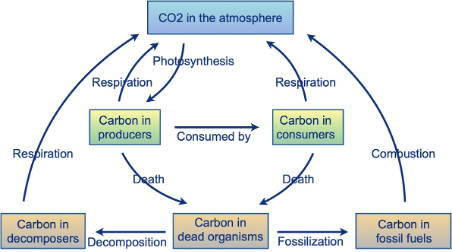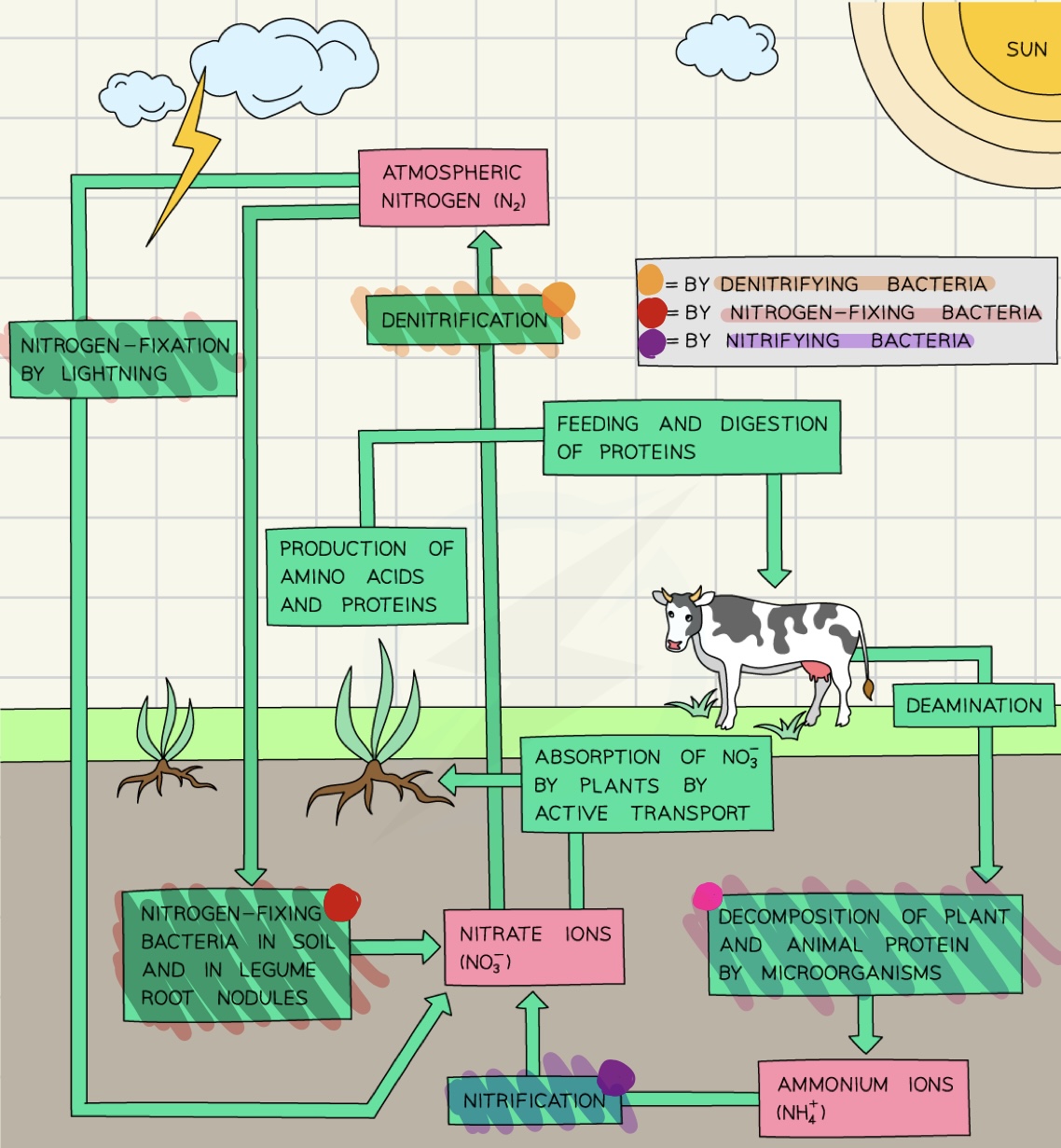2.5 - carbon and nitrogen cycles, Harber process
1/23
There's no tags or description
Looks like no tags are added yet.
Name | Mastery | Learn | Test | Matching | Spaced |
|---|
No study sessions yet.
24 Terms
biogeochemical cycles
processes that recycle nutrients and elements through the Earth's ecosystems so:
the elements can continue to be available to living organisms
*finite resources must be cycled around ecosystems constantly is life is to be sustained
carbon cycle
processes through which carbon compounds are circulated in the environment

carbon stores
organic (complex carbon molecules)
organisms in the biosphere
fossilized life forms
inorganic (simple carbon molecules)
locked up/ fixed as
sedimentary rocks
fossil fuel
lime stone
locked up/ fixed as carbon in shells
soil
carbon flows
transformations
respiration
photosynthesis
combustion
transfers
feeding
defecation
death and decomposition
carbon sequestration
the process of capturing and storing atmospheric carbon dioxide to mitigate climate change.
agricultural systems and effect on carbon cycle
no till farming
without ploughing soil is protected from erosion and organic matter loss
cover cropping
planting 2nd crop to protect soil and the decay nourishing the 1st cash crop
crop rotation
ensures no nutrient depletion
agroforestry
planting trees in agricultural land to increase biomass and sequestrate CO2 improving soil structure
rice paddy fields
waterlogged rice fields release methane
human impacts on carbon cycle
fossil fuels are carbon sinks and when burned become carbon sources releasing carbon into atmosphere
agricultural systems acting as
carbon sinks
carbon sources
oceanic carbon dynamics
human impacts on carbon cycle: agricultural systems
carbon sinks
regenerative techniques
increase amount of organic matter in soil
carbon sources
drainage of wetlands
monoculture farming
intensive tillage
loss of organic matter
reduced biodiversity
increased release of carbon from soils
human impacts on carbon cycle: oceanic carbon dynamics
ocean acts as a carbon sink
burning more fossil fuels releases more carbon at a faster rate than oceans can absorb
warming temperatures due to climate change reduce ability to act as carbon sink
increased carbon dissolved in oceans lowers the pH leading to ocean acidification
weakened shells
less diverse reef structure
solutions to human impacts on carbon cycle
low carbon technologies
reduction in fossil fuels burning
reduction in soil disruption
increasing reforestation
carbon capture and sequestration
ocean fertilization
adding compounds to stimulate phytoplankton growth that absorbs CO2
carbon sinks
CO2 intake > CO2 release
forests
wetlands
oceans
soil and rocks
carbon stores
CO2 intake ≈ CO2 release
carbon sources
CO2 intake < CO2 release
deforestation
fossil fuel combustion
industrial processes
nitrogen cycle
The process through which nitrogen is circling between its stores through being converted between its various chemical forms.

nitrogen stores
organic
protein of living organisms
DNA
dead organic matter
inorganic
atmosphere
N2 gas
soil and water
NH3 ammonia
NO2- nitrites
NO3- nitrates
nitrogen flows
transfers
mineral uptake
consumption
excretion
death and decomposition
transformations
nitrogen fixation
bacteria
lightning
nitrification (nitrifying bacteria)
denitrification
ammonification
role of bacteria in nitrogen cycle
nitrogen fixation
rhizobium bacteria coverts N2 gas into ammonia NH3
then can be used by plants
happens in:
soil
legumes with nitrogen-fixing bacteria
nitrification
nitrifying bacteria convert ammonia NH3 into nitrites NO2- and then into nitrates NO3-
then plants absorb these nitrates through roots
denitrification
denitrifying bacteria convert nitrates NO3- back into nitrogen gas N2
nitrogen gas returns to the atmosphere
happens in:
anaerobic conditions (waterlogged soils)
decomposition/ ammonification
decomposing bacteria breaks down the nitrogenous compounds into ammonium NH4
happens in: soil

mutualistic relationships and nitrogen fixation
plants cannot use nitrogen gas directly
some plants such as legumes form relationships with nitrogen-fixing bacteria
competitive advantage in nitrogen-poor soils
human influences on nitrogen cycle
deforestation
reduces amount of vegetation that can absorb nitrogen from soil for growth
leads to nitrogen leaching into water bodies
euthropication, algal blooms, dead zones
urbanisation
sewage contains nitrogen
enters water bodies increasing nitrogen levels
storm water runoff
vehicle emission
reacts with water vapour and forms acid rain
aquaculture
fish farms use fertilisers and antibiotics
pollute water bodies
excess nitrogen and ammonia
agriculture
nitrogen fertilisers
increased rates of denitrification
leaching nitrate into groundwater
eutrophication
Haber process
A method to synthesize ammonia from nitrogen and hydrogen gases:
under high temperature
under high pressure
in the presence of a catalyst
primarily used in fertilizers.
N2 + 3H2 ⇌ 2NH3
advantages of the Haber process
increased crop yields
reliable and large scale source of nitrogen fertilisers
food security
reduced land use
disadvantages of the Haber process
environmental impact
runoff
eutrophication
dead zones → reduced biodiversity
energy consumption
is reliant on fossil fuels and contributes to greenhouse gas emission
pollution
fertiliser runoff
soil health
over reliance on synthetic fertilisers can degrade soil health
disrupting natural nutrient cycles
reduced soil biodiversity
need for global collaboration in relation to nitrogen cycle
shared responsibility
nitrogen pollution affects ecosystems and human health worldwide
agreements and policies
existing frameworks provide ground for collaborations on nitrogen management
solutions to disrupted nitrogen cycle
efficient fertiliser use
promoting sustainable agriculture
crop rotation
precision farming
reduced nitrogen emission
promoting alternative nitrogen sources